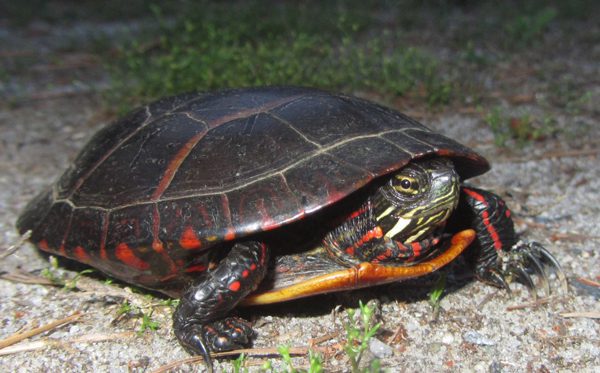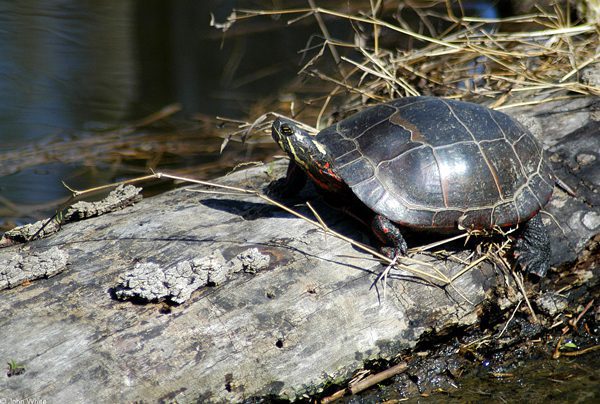One tough turtle

Have you ever been out swimming or kayaking in the streams and lakes of North Carolina and seen turtles sunning themselves on rocks and logs? If so, then chances are that you have spotted the painted turtle at least once.
The painted turtle (Chrysemys picta) is one of the most common and widespread species of turtle across the North American continent, found nearly everywhere in North Carolina. The map (right) shows the painted turtle range in North Carolina (click to go to source for photo).
 Though the species is common, painted turtles have many characteristics that make them unusual. One example is their adaptability to many environments.
Though the species is common, painted turtles have many characteristics that make them unusual. One example is their adaptability to many environments.
Like many other species of turtle, painted turtles live in freshwater habitats such as streams, lakes and marshes. However, they can also thrive in harsh settings unsuitable for many others. A study published in 2010 found that in the Charlotte area, dense, stable populations of painted turtles were found in ponds on farms, a golf course, and even in urban development sites. So if you find a turtle in your yard, don’t assume it needs to be relocated – it is probably best to simply leave it where you find it.
As a further testament to their ability to survive in a range of habitats, painted turtles are one of only two known species of turtle that can survive freezing during the winter and subsequent thawing in the spring, allowing them to live as far north as southern Canada.
In their habitats, painted turtles play an important role as predators for small fish and invertebrates, as well as consumers of aquatic plants and algae. The turtles also serve as a food source for raccoons, otters, mink and foxes.
These turtles are one of the easiest to identify because of their distinctive appearance. They have flat, brownish-black shells, often with red markings around the edges, and yellow and red stripes running along their heads, limbs and tails. Due to these beautiful markings and their docile temperament, painted turtles are a popular choice for home aquaria.
They are a sexually dimorphic species, which means that the females differ in appearance from the males, and females generally grow larger than males. Males have longer front claws and tails. Males can also be identified by their concave undersides, which aid in mating.

Females reach maturity between six to ten years of age, while males reach full maturity between three and five. Mating typically occurs late spring and early summer. Females lay four to 14 soft-shelled eggs in sandy burrows with a lot of sunlight.
Unlike many other types of animals, painted turtles lack sex chromosomes. Instead, the temperature within the burrow will determine the sex of the offspring. At 22 degrees Celsius and below, male offspring are produced and at warmer temperatures, females are produced.
The eggs do not hatch until the subsequent spring, when the hatchlings dig out of the nest. They get no parental care. If they survive to maturity, the hatchlings will live an average of 30 years, but could live as long as 40. For a relatively small species that must face some pretty harsh conditions, thanks to a variety of unique survival characteristics, it is one tough little turtle.
Fast facts for painted turtles:
- Range: Southern Canada to Mexico;
- Habitat: freshwater lakes, ponds, rivers, and swamps
- Lifespan: 30-40 years
- Appearance: brown-black shell with red and yellow facial and limb markings
- Diet: omnivorous, consume small fish and crustaceans as well as plants
Other interesting facts:
- Sunning behavior keeps them warm, but also helps get rid of parasitic leeches.
- They are active during the day and sleep at night at the bottom of lakes or on rocks
- They hibernate in the mud during the winter
Emily Marino wrote this article while interning for the LandTrust for Central North Carolina in 2014. At the time she was a student at Duke University.
Photo above is from http://www.fcps.edu/islandcreekes/ecology/eastern_painted_turtle.htm
Emily Marino